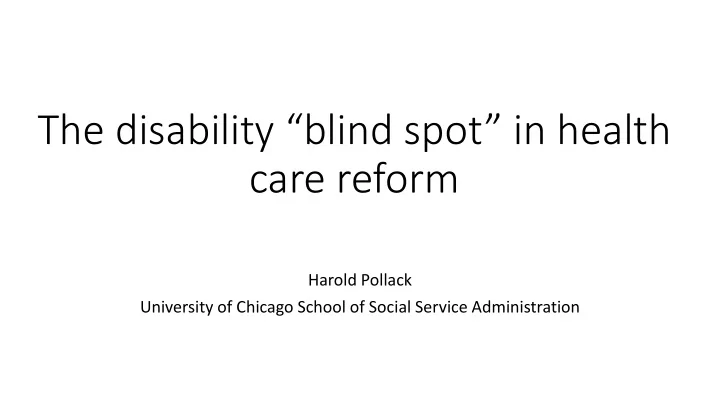

The disability “blind spot” in health care reform Harold Pollack University of Chicago School of Social Service Administration
Faces of disability: Mariam Pare
The fundamental reality and dilemma • In its human reality, disability is a multi-dimensional and continuous set of functional limitations that interact with the real-world environment. • Is my myopia a disability? • How about a graduate of University of Chicago Law School who uses a wheelchair? • Is a coal minor with mild depression and back pain disabled? • Same coal minor with an Oxycodone problem? • Same coal minor. He can actually work, but the only available work is minimum wage. • Importance of Medicaid expansion for people with disabilities.
ACA as a missed opportunity on many fronts • Preexisting conditions, Medicaid expansion, and other gains • Failed CLASS Act. • Disability community rather peripheral to original ACA fight, with distinctive political interests not universally shared in ACA coalition • Played central role in defending ACA and Medicaid, earned seat at the table • But…disability policy as costly and complicated as the rest of health policy combined. • Looming LTC issue • What to do with fifty years of Medicaid wiring • A lot more.
Disability community defending ACA
Waiting lists for services • 707,000 people on HCBS waiver waiting lists in 40 states as of 2017. • 281,000 in Texas, 66,000 in Louisiana, 68,000 in Ohio • 19,354 in Illinois, 0 in Massachusetts. • People living with intellectual and developmental disabilities (I/DD) comprise about two-thirds of waiting list enrollment. • One-quarter are seniors and adults with physical disabilities. • Wait lists have been growing about 8% per year.
Emerging consensus (among Democrats) • SSI countable asset limit • Last raised in 1989 • Adjusted for inflation, about ¼ of its value in 1975. • Buttigieg, Warren, and Sanders seek to raise it. • Others across the political spectrum agree — but this is costly. • Eliminate Medicare waiting period for those qualifying for SSDI • ABLE accounts • Other challenges • Presumptive eligibility for Medicaid HCBS for individuals who cross state lines. • National Medicaid buy-in for all who satisfy disability criteria. • LTSS through Medicaid expansion.
IDD reflects quiet successes of American disability policy • Social acceptance and support • Changes in popular culture and social norms. • The line at ORD security • Legal protections • Olmstead , ADA, IDEA • Entitlement security, expenditure growth • So much more.
It’s good to consider where we were not so long ago • Consider America in 1945 or 1960, let alone 1930. • I/DD was considered a private tragedy not a public policy challenge. • 1944, Eric and Joan Erickson had a child diagnosed with Down’s Syndrome. They concealed the child from their other children, saying that he had died at birth. • Limited schooling and care supports • Institutional care often the only supports • Community-based services essentially did not exist. • Limited lifespan and significant medical challenges facing individuals with I/DD
It’s also good to consider what individuals and families confront with other conditions and disorders • Social and family stigma much more intense for severe mental illnesses than with severe mental illness. • Popular culture and public supports also much more generous in the case of IDD than SMI. • Implications of such patterns for policy proposals such as Medicaid bloc grants.
Images of IDD in popular culture
Pop culture representations of SMI
Distribution of supportive housing for persons w/psychiatric and developmental disabilities (Wong and Stanhope 2009)
That (selective) social acceptance has historical roots
The modern story begins roughly 1946 • WWII conscientious objecters sent to state institutions, and wrote about what they saw: • Channing Richardson “100,000 Defectives” Christian Century 1946 • Inhumane conditions reminiscent of other places … • Burnout and cruelty committed by overburdened, undertrained staff. • Presence of people with normal- range IQ’s wrongly institutionalized, and more. • Women caregivers began to write about their experiences.
The pioneering generation of caregiver community organizers • In 1946, Laura Blossfeld placed an ad in a Bergen County newspaper. • Her pitch might have been drawn from a political science textbook or a social media mobilization campaign: • “ Each parent can ultimately help his own child by doing something to help all children similarly affected . . . . Therefore I suggest an organization for all parents of mentally retarded children, [one that] may well prove to be the first chapter in a nationwide organization.” • In 1949, a New York City housewife placed a similar newspaper advertisement: • “ Surely there must be other children like [her son], other parents like myself. Where are you? Let’s band together and do something for our children!”
The pioneering generation of caregivers • Middle-class women who began to find each other, founded and spread NARC some of the greatest community organizers in American history. • Impossible to imagine recent history we’re familiar with (ADA, Olmstead litigation, etc.) without that grassroots mobilization. • Alliance of policy expertise with evidence-based political advocacy to affect change.
Thank you
Recommend
More recommend